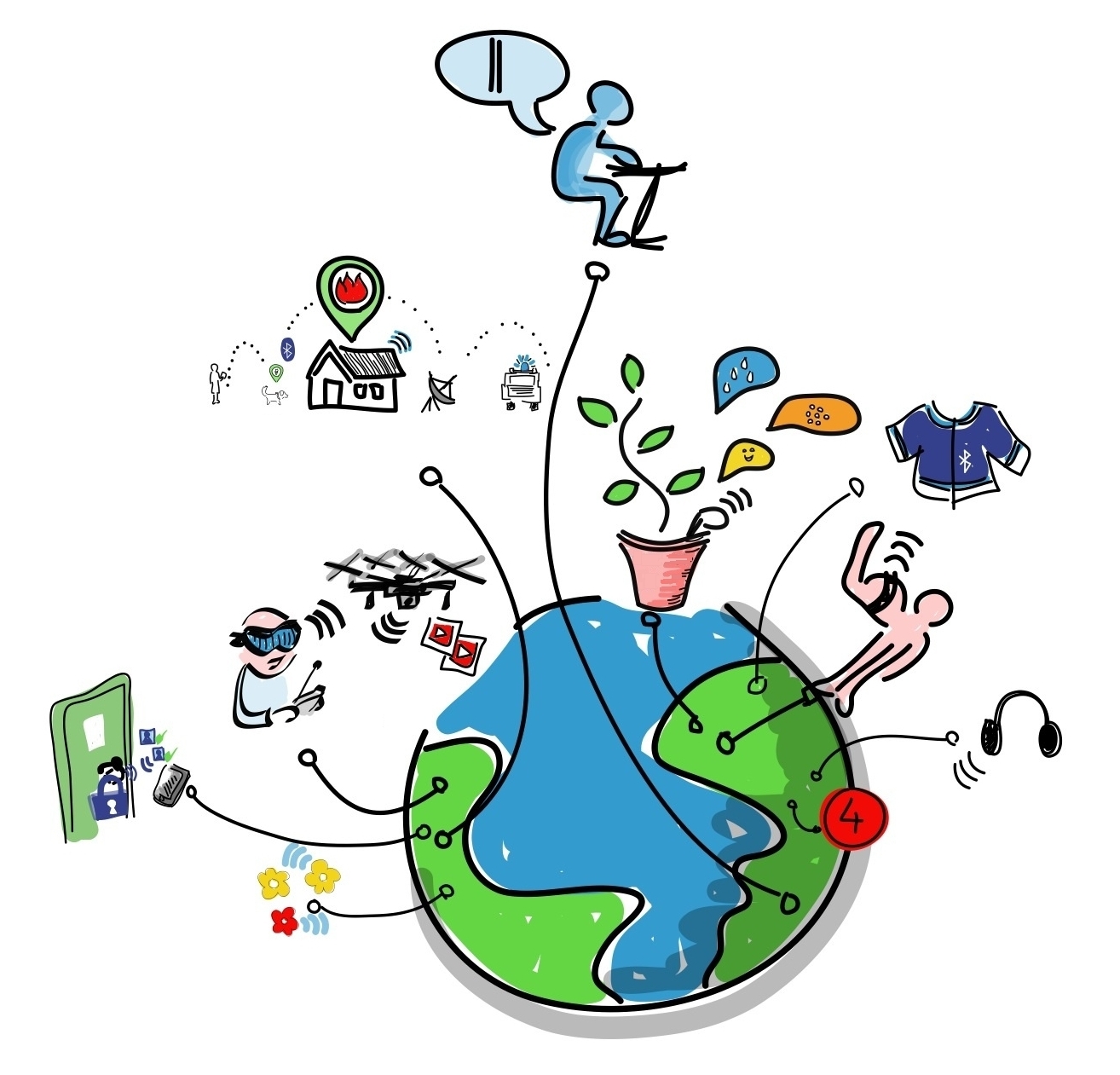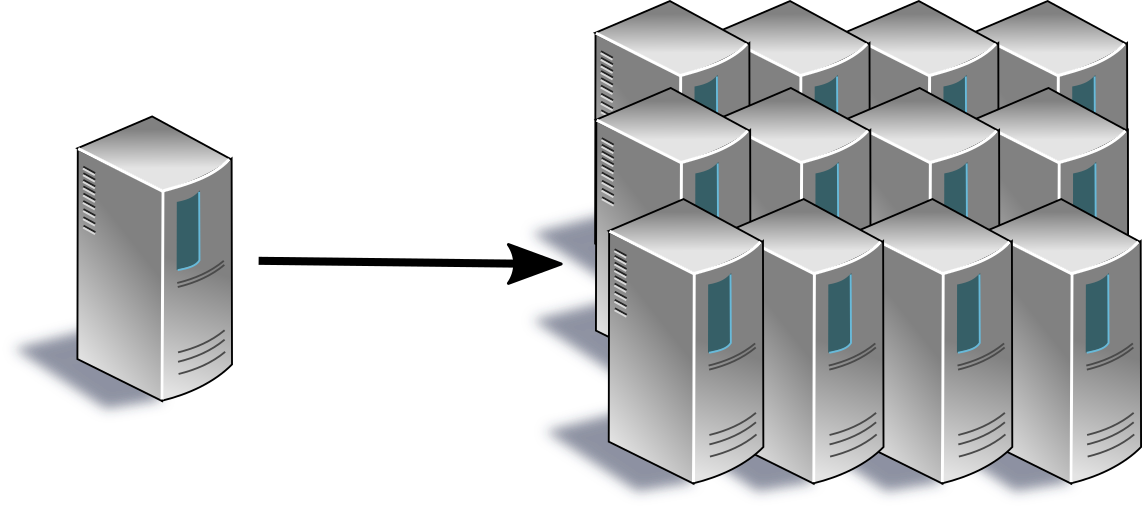Cloud Computing
(Usage hints for this presentation)
IT Systems, Summer Term 2025
Dr. Jens Lechtenbörger (License Information)
1. Introduction
1.1. Core Questions
- What is a distributed system?
What do “cloud computing” and “serverless computing” mean?
![Cloud of computers as abstract execution environment]()
- How do they help to build distributed systems?
- How to manage a cloud of computers?
1.2. Learning Objectives
- Explain distributed systems with their basic scalability techniques.
- Explain and contrast cloud computing and serverless computing based on definitions and examples.
- Explain concepts for container orchestration in general and with Kubernetes
- Including horizontal scaling for stateless servers
- (Commands and YAML syntax are not part of learning objectives)
- Explain digital sovereignty and cloud repatriation
1.3. Retrieval practice
- What is digital sovereignty?
- Introduced as course goal
- Revisited in OS part
- With free software
as precondition
- Similarly for free firmware (and hardware)
- With free software
as precondition
- What is caching?
- What is server consolidation?
- What is Kubernetes?
Agenda
- Part 1
- Part 2
2. Distributed Systems

“Internet of Things” by Wilgengebroed on Flickr under CC BY 2.0; from Wikimedia Commons
2.1. Definitions
A distributed system (DS) is …
Leslie Lamport: “one in which the failure of a computer you didn’t even know existed can render your own computer unusable”
![Photo of Leslie Lamport]()
“Photo of Leslie Lamport” under CC0 1.0; from Wikimedia Commons
- (Lamport is Turing Award winner, also with seminal contributions to DSs)
- Tanenbaum and van Steen (Tanenbaum and Steen 2007): “a collection of independent computers that appears to its users as a single coherent system”
Coulouris et al. (Coulouris et al. 2011): “a system in which hardware and software components located at networked computers communicate and coordinate their actions only by passing messages”
- Comments, examples in notes
2.2. Internet vs Web
Major concepts
Internet: Network of networks, an internetwork
- Each network with hosts and links
E.g., our home networks, university networks, ISPs, etc.
- Connectivity for heterogeneous devices in DSs, regardless of their home network
Connectivity enabled by various protocols
IPv4 and IPv6 for host-to-host connectivity (IP = Internet Protocol)
DNS translates human-readable names to IP addresses, e.g.,
www.uni-muenster.deto128.176.6.250(IPv4) or2001:4cf0:2:20::80b0:6fa(IPv6)TCP, UDP, QUIC for process-to-process connectivity (e.g., process of web browser talks with remote process of web server)
The web is an application using the Internet
- Clients and servers talk HTTP (another protocol)
- E.g.,
GETrequests of HTTP ask for HTML pages (and more) - Web servers provide resources to web clients (browsers, apps)
- E.g.,
- Clients and servers talk HTTP (another protocol)
- Internet and web contain DSs
2.3. Technical DS Challenges
- No shared memory, but message passing
- Concurrency
- Autonomy and heterogeneity
- Neither global clock nor global state
- Independent failures
- Hostile environment, safety vs security
2.4. DS Goals
- Make resources accessible
- E.g., CPUs or GPUs, printers, files, communication and collaboration
- Openness
- Accepted standards, interoperability
- Various distribution transparencies
- Scalability
(Source: (Tanenbaum and Steen 2007))
2.4.1. Distribution Transparencies
- Transparency = Invisibility (hide complexity)
- Sample selection of transparencies from ISO/ODP (Farooqui, Logrippo, and de Meer 1995)
- Location t.: clients need not know physical server locations
- Migration t.: clients need not know locations of objects, which can migrate between servers
- Replication t.: clients need not know if/where objects are replicated
- Failure t.: (partial) failures are hidden from clients
2.4.2. Scalability
Dimensions of scale
- Numerical: Numbers of users, objects, services
- Geographical: Distance over which system is scattered
- Administrative: Number of organizations with control over system components
Typical scalability techniques for IT systems
Scale up: Improve hardware; limited potential
Scale out (horizontal scaling): Use partitioning and replication; (almost) unlimited potential
(Based upon: (Neuman 1994))
2.4.3. Replication
- To replicate = to copy to multiple machines/nodes
- Copies (or nodes managing them) are called replicas
- E.g., manually forked and cloned repositories with Git or automatically managed redundancy with HFDS or Kubernetes
- Copies (or nodes managing them) are called replicas
Positive effects
- Increased availability (usability in presence of faults)
- System usable as long as “enough” replicas available
- Reduced latency
- Use local or nearby replica
- Increased throughput
- Distribute/balance load among replicas
- Increased availability (usability in presence of faults)
Challenge: Keep replicas in sync (consistent)
2.4.4. Caching
To cache = to save (intermediate) results close to client
- Temporary form of replication, e.g.:
- CPU caches keep data from RAM closer to CPU; in turn, RAM acts as cache for data from disk; in turn, disks act as caches for “cloud” data
- Browser caches for web resources
- SIEVE algorithm for caching
- Temporary form of replication, e.g.:
- Positive effects
- Reduced load on server/origin
- Increased availability and throughput as well as reduced latency as with replication
- Challenge: Keep cache contents up to date
2.4.5. Partitioning
- To partition = to spread data or services among multiple
machines/nodes
- Each node responsible for subset
- (Sharding = partitioning in shared-nothing architecture)
- Effects
- Reduced availability: each node is additional point of failure
- If node fails, its data/services are not available
- (To improve availability, partitioning usually paired with replication)
- Reduced latency and increased throughput
- Each node operates on (small) subset
- (Partial) results on subsets produced fast; combined into overall result
- Nodes operate in parallel
- (Think of search in large set of data)
- Each node operates on (small) subset
- Reduced availability: each node is additional point of failure
3. Cloud Computing
3.1. Computing as Utility
Computing as 5th utility (Buyya et al. 2009)
“Computing is being transformed to a model consisting of services that are commoditized and delivered in a manner similar to traditional utilities such as water, electricity, gas, and telephony. In such a model, users access services based on their requirements without regard to where the services are hosted or how they are delivered.”
- Subscription-based pay-per-use of complex IT infrastructure,
without heavy up-front investment/developments
- Flexibility
- Economies of scale for providers
- Server consolidation with virtualization: Optimized use of hardware and space, energy, cooling
3.2. NIST Definition
![NIST Visual model of cloud computing definition]()
“NIST Visual model of cloud computing definition” by P Naveen, Wong Kiing Ing, Michael Kobina Danquah, Amandeep S Sidhu, and Ahmed Abu-Siada under CC BY 3.0; from Fig. 2 in P Naveen et al 2016 IOP Conf. Ser.: Mater. Sci. Eng. 121 012010
- “Cloud computing is a model for enabling ubiquitous, convenient,
on-demand network access to a shared pool of configurable
computing resources (e.g., networks, servers, storage,
applications, and services) that can be rapidly provisioned and
released with minimal management effort or service provider interaction.
This cloud model is composed of five essential characteristics,
three service models, and four deployment models.”
- (Emphasis added)
- “Cloud computing is a model for enabling ubiquitous, convenient,
on-demand network access to a shared pool of configurable
computing resources (e.g., networks, servers, storage,
applications, and services) that can be rapidly provisioned and
released with minimal management effort or service provider interaction.
This cloud model is composed of five essential characteristics,
three service models, and four deployment models.”
(Figure source: (Naveen et al. 2016))
3.2.1. NIST Definition: Characteristics
- On-demand self-service
- Users provision servers with CPUs, memory, storage, networking
- Without human interaction with service provider
- Users provision servers with CPUs, memory, storage, networking
- Broad network access
- Capabilities accessible over Internet
- Resource pooling
- Provider’s computing resources assigned dynamically to multiple consumers
- Multi-tenant
- Customers without knowledge/control of exact locations
- Provider’s computing resources assigned dynamically to multiple consumers
- Rapid elasticity
- Capabilities quickly scalable up or down
- Illusion of unlimited resources
- Measured service
- Cloud systems control and optimize resource usage
- For both providers and consumers
- Cloud systems control and optimize resource usage
(Source: (Mell and Grance 2011))
3.2.2. NIST Definition: Service Models
- Infrastructure as a Service (IaaS)
- Consumers deploy arbitrary software in VMs on provider’s cloud
infrastructure
- “VMs in the cloud”, e.g., major cloud providers and project seminar servers
- Consumers deploy arbitrary software in VMs on provider’s cloud
infrastructure
Platform as a Service (PaaS)
- Consumers deploy applications using programming languages,
libraries, and tools supported by provider
- “Programming environment in the cloud”, e.g., major cloud providers
- Consumers deploy applications using programming languages,
libraries, and tools supported by provider
Software as a Service (SaaS)
- Consumers use provider’s applications on cloud infrastructure
- “Applications in the cloud”, e.g., office suite, CRM system, ERP system
- Consumers use provider’s applications on cloud infrastructure
(Anything as a Service (XaaS))
- (X = Container, Function, Backend, Database, …)
3.2.3. NIST Definition: Deployment Models
- Public cloud
- Company manages cloud to be used by others
- Private cloud
- Organization operates its own cloud
- Exclusive use
- Community cloud
- Community of consumers operates their own cloud
- Hybrid cloud
- Two or more distinct private, community, or public cloud infrastructures
- Standards for data and application portability
3.3. Cloud Caveats
-
- Provider reliability
- Vendor lock-in
- Security and privacy concerns
- Data and code on someone else’s machines
- Who has access when? Misconfigurations?
- See (Buyya et al. 2018) for selected techniques, e.g., homomorphic encryption
- Beware of marketing claims
- E.g., see Google’s 2024 analysis of “Microsoft’s ongoing security struggles”
4. Serverless Computing
- (Kounev et al. 2023)
- “Serverless computing is a cloud computing paradigm encompassing a class of cloud computing platforms that allow one to develop, deploy, and run applications (or components thereof) in the cloud without allocating and managing virtualized servers and resources or being concerned about other operational aspects.”
- Provider is responsible for operational aspects, e.g., fault tolerance, elastic scaling
- Pay-per-use with fine granularity
- Examples include AWS Lambda, Google Cloud Functions
- “Serverless computing is a cloud computing paradigm encompassing a class of cloud computing platforms that allow one to develop, deploy, and run applications (or components thereof) in the cloud without allocating and managing virtualized servers and resources or being concerned about other operational aspects.”
4.1. Self-Study
- How do the above service models of cloud computing relate to serverless computing?
4.2. Sample Serverless Applications
Anomaly detection for industrial sensors
- Cloud functions consume micro batches, e.g., thresholding or machine learning for anomaly detection
-
- (Unlimited) storage of data with meta-data under unique identifiers
- No details of servers necessary
Serverless databases, SQL-as-a-Service
- Capacity planning and autoscaling included
Serverless edge or fog computing
- Computation and storage close to data sources
- (In contrast to shipping of data to central data centers for computations)
- E.g., real-time computer vision or analytics for mobile or (resource-constrained) IoT devices
- Computation and storage close to data sources
(Source: (Kounev et al. 2023))
Bibliography
License Information
Source files are available on GitLab (check out embedded submodules) under free licenses. Icons of custom controls are by @fontawesome, released under CC BY 4.0.
Except where otherwise noted, the work “Cloud Computing”, © 2018-2025 Jens Lechtenbörger, is published under the Creative Commons license CC BY-SA 4.0.





